Type 1 Diabetes Market Size and Trends
Global type 1 diabetes market is estimated to be valued at USD 16.97 Bn in 2025 and is expected to reach USD 26.22 Bn by 2032, exhibiting a compound annual growth rate (CAGR) of 6.4% from 2025 to 2032.
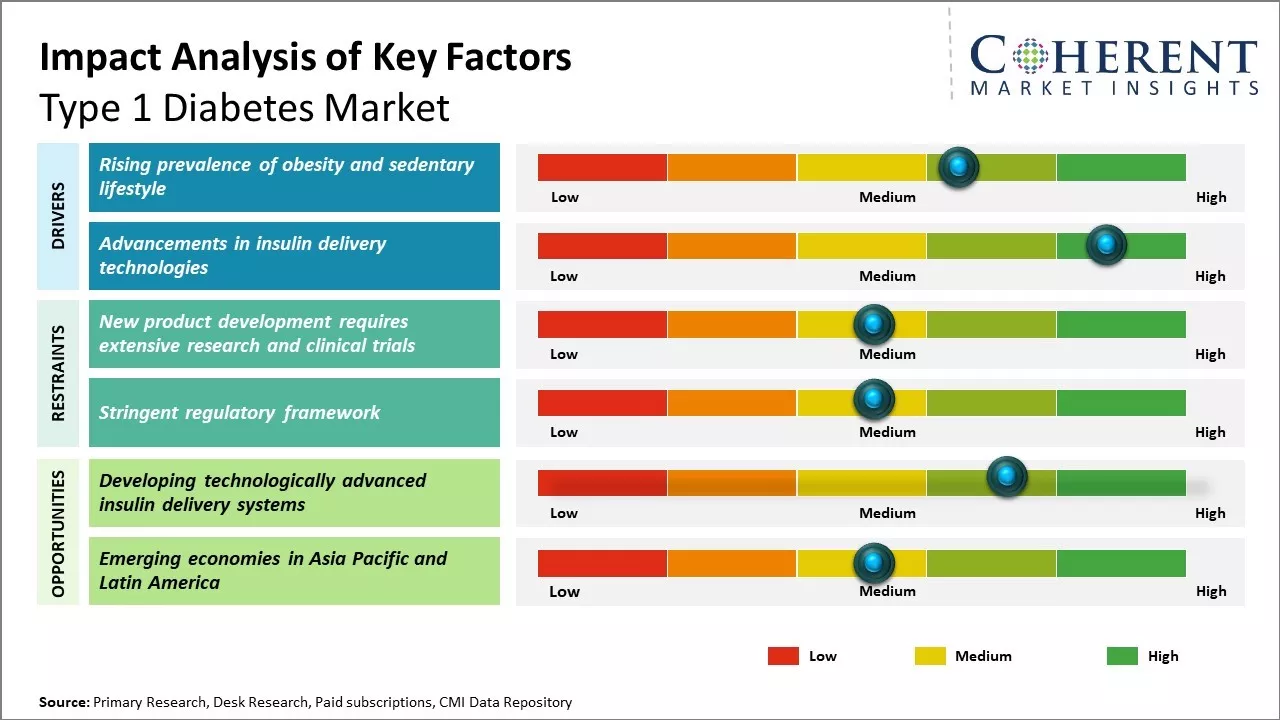
Discover market dynamics shaping the industry: Download Free Sample
Global Type 1 diabetes market is witnessing positive growth trends due to rising prevalence of the disease. Increasing awareness about diabetes self-care and management along with technological advancements in insulin delivery devices are some key factors aiding the market expansion. Improved diagnostic capabilities and mass screening programs have enabled faster diagnosis and treatment of type 1 diabetes. However, high cost of insulin drugs continues to remain a major challenge, especially in low- and middle-income countries. Many players are engaged in developing affordable biosimilar insulin therapies to increase accessibility.
Rising prevalence of obesity and sedentary lifestyle
Increasing prevalence of obesity and physical inactivity is one of the key drivers propelling the growth of type 1 diabetes market. Poor dietary choices and lack of exercise have led to a surge in obesity rates globally. While the exact biological mechanisms are unknown, excess body weight is believed to place additional stress on the pancreas, increasing the chances of autoimmune destruction of insulin-producing beta cells. At the same time, more and more people worldwide are adopting sedentary habits and desk-bound occupations with little or no physical activity. Lack of exercise negatively impacts glucose regulation and insulin sensitivity over the long run. When combined with obesity, physical inactivity doubles the risk of developing type 1 diabetes, thereby, boosting demand for treatment of type 1 diabetes.
Market Concentration and Competitive Landscape
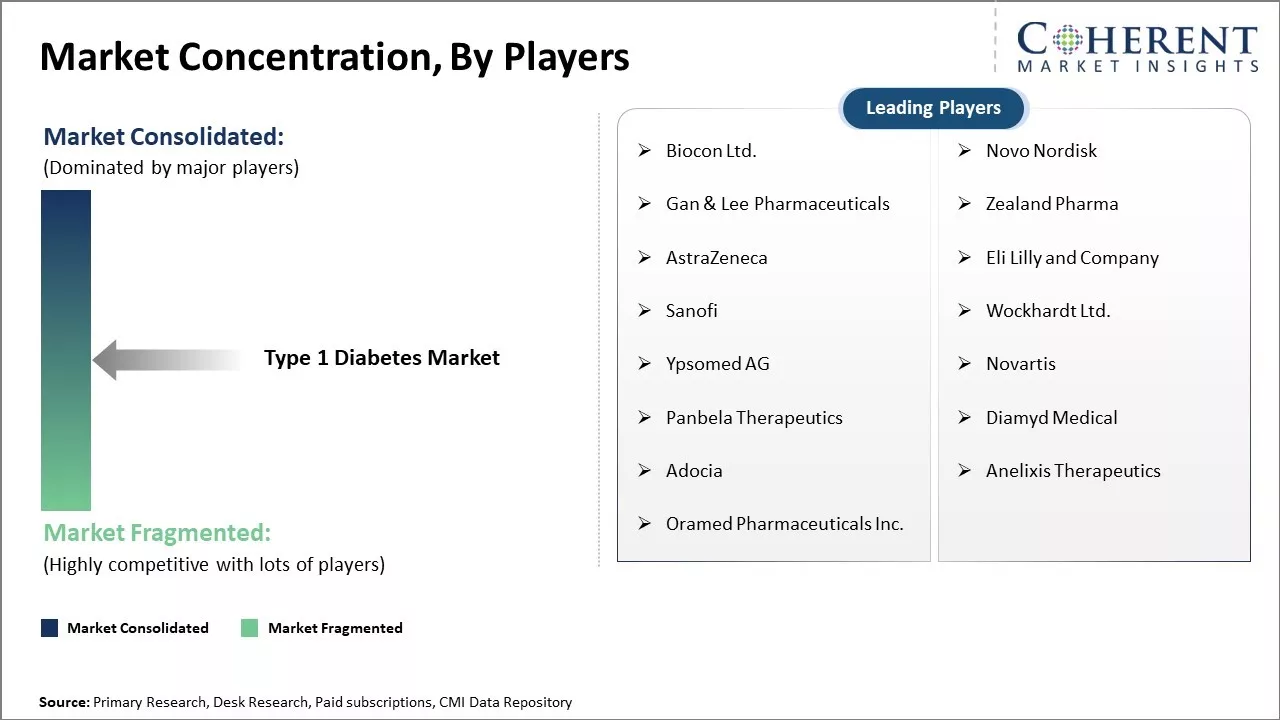
Get actionable strategies to beat competition: Download Free Sample
Advancements in insulin delivery technologiesTechnological advancement is another key factor contributing to the growth of the type 1 diabetes market. Insulin injections via syringes were the standard method of treatment. However, continuous subcutaneous insulin infusion via insulin pumps and smart insulin pens have significantly improved diabetes management in recent years. These modern insulin delivery devices automatically provide small doses of insulin continuously throughout the day to mimic the body's natural insulin release. Compared to multiple daily injections, insulin pumps are more convenient to use and allow for better blood glucose control. Newer pump models can be remotely controlled via companion apps on smartphones and connected to continuous glucose monitoring systems for added precision. Similarly, smart insulin pens that record dosing information are gaining widespread acceptance. These provide tracking of insulin on board which is helpful for determining correct bolus doses during meals or illness.
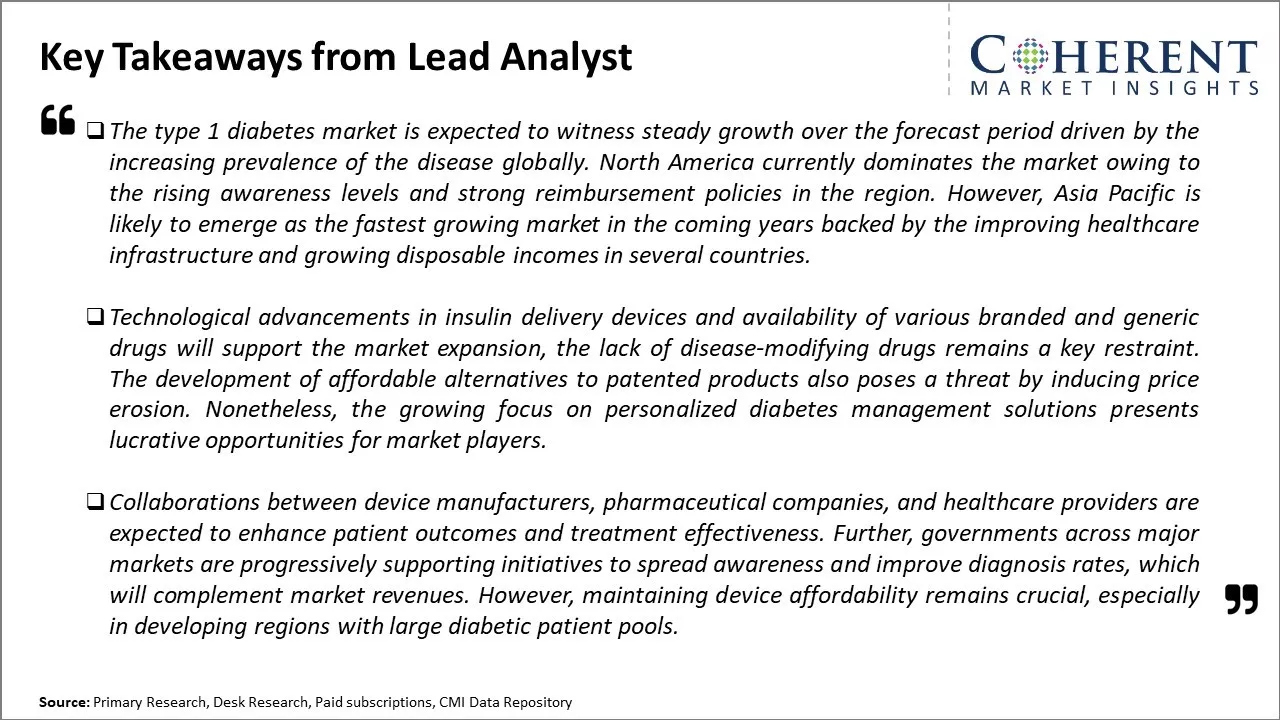
To learn more about this report, Download Free Sample
Market Challenges: New product development requires extensive research and clinical trialsGlobal type 1 diabetes market faces several challenges. Due to the complex nature of the disease, developing innovative treatment options requires extensive research and clinical trials, resulting in high costs. The routes of insulin administration currently available pose pain and inconvenience challenges for patients. The involvement of multiple devices and manual oversight of insulin dosing regimens place a high treatment burden on patients. Maintaining strict glucose control also poses risks of hypoglycemia. As the underlying cause of type 1 diabetes is still unknown, a permanent cure remains elusive.
Market Opportunities: Developing technologically advanced insulin delivery systems
Newer insulin delivery technologies that are being researched aim to address some of the shortcomings of existing options and provide better management of the condition. For example, closed loop insulin delivery systems which are also called artificial pancreas systems automatically monitor blood glucose levels using a continuous monitor and calculate and deliver the required insulin dose via an infusion pump. This helps reduce the burden of numerous blood glucose checks and insulin administration decisions on patients.
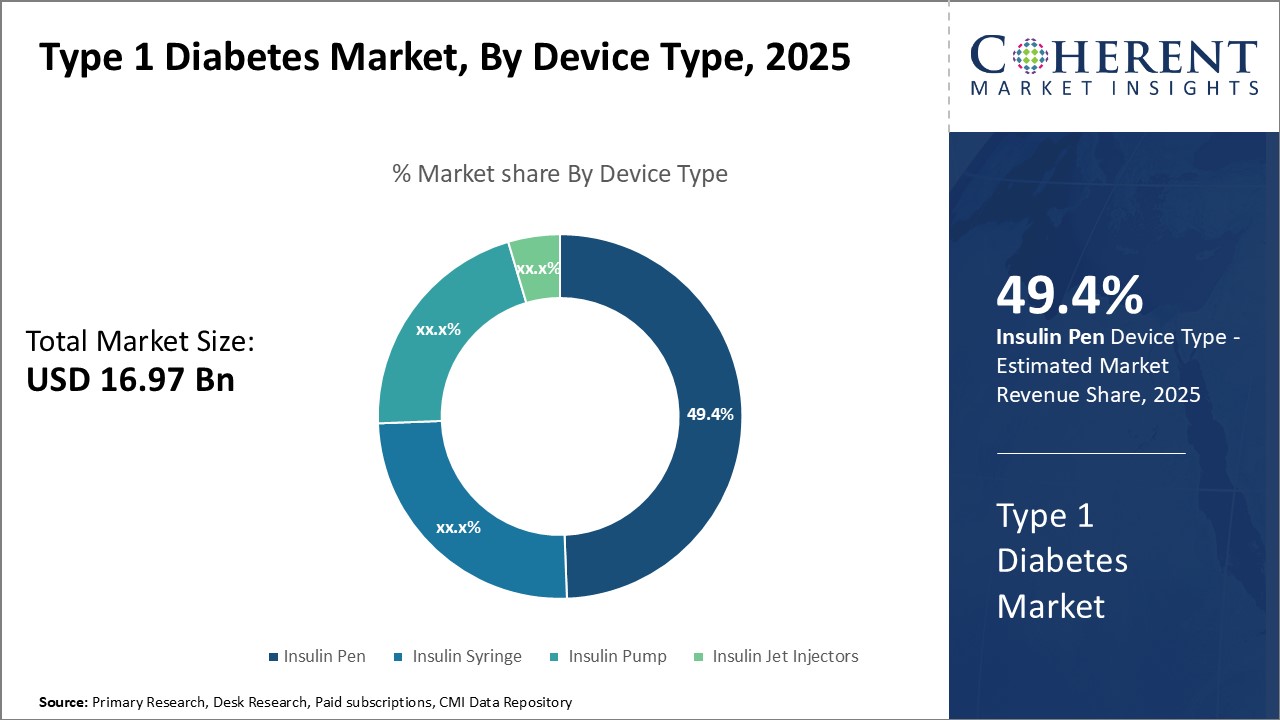
Discover high revenue pocket segments and roadmap to it: Download Free Sample
Insights, By Device Type: Convenience and discretion boosts insulin pen adoptionDevice type segment is sub-segmented into insulin pen, insulin syringe, insulin pump, and insulin jet injectors. Insulin pen segment is anticipated to hold 49.4% of the market share in 2025. Insulin pens provide an easy, discreet and timesaving method for insulin delivery compared to syringes. Pens allow users to pre-fill cartridges with insulin doses, eliminating the steps of drawing insulin from a vial and reducing dose measurement errors. This streamlined process makes insulin administration quicker and hassle-free. Pens are also much smaller than syringes, allowing for discreet insulin delivery. This is a major advantage as it does not draw attention to the user’s medical condition. The portable design of insulin pens also makes them convenient for on-the-go insulin administration. Users can easily carry pre-filled pens with them and take insulin doses as required without having to carry syringes, vials and other paraphernalia. This mobility boosts treatment adherence for active lifestyles. Additionally, pen needles are less painful as these are very thin and short compared to syringe needles. This reduces fear of injections and boosts willingness to self-administer insulin regularly.
Insights, By Insulin Type: Long-term glycemic control boosts preference for long-acting insulin
Insulin type segment is sub-segmented into long-acting insulin and rapid-acting insulin. Long-acting insulin segment is estimated to contribute the highest share of the type 1 diabetes market and is projected to hold 67.3% of the market share in 2025. Long-acting insulin remains in the bloodstream for an extended period, keeping baseline insulin levels stable between meals and overnight. This steady insulin coverage mimics the body's natural insulin secretion and prevents high and low blood sugar levels. It allows consistent all-day glycemic control without frequent dosing. This makes long-acting insulin a preferred choice for Type 1 diabetes patients relying on multiple daily injections or continuous pump infusion. It also suits those managing rigorous activities or irregular schedules as the consistent insulin effect provides flexibility. The long duration of action reduces risks of hypoglycemia from missed or delayed doses. It is commonly combined with rapid-acting insulin to cover mealtime spikes. The slow absorption and prolonged action of long-acting insulin allows once-daily or twice-daily dosing, increasing treatment convenience. This boosts medication adherence needed to achieve optimal glycemic management.
Insights, By Distribution Channel: Convenience drives demand of retail pharmacies
Distribution channel segment is sub-segmented into hospital pharmacies, retail pharmacies, and online pharmacies. Retail pharmacies segment is estimated to contribute the highest share of the type 1 diabetes market and is projected to hold 45.3% of the market share in 2025. Retail pharmacies provide widespread accessibility and availability of diabetes supplies. Their large numbers and presence in local communities ensures diabetes devices and medications are easily reachable. This convenient access encourages patients to refill prescriptions and replenish supplies routinely. Retail pharmacies also offer direct sale of certain diabetes products without prescription. Their walk-in convenience competes with online and hospital routes that require shipping delays or appointments. The customer service and product portfolios of retail pharmacies also aim to meet varying needs. Larger stores stock comprehensive lines of meters, pumps, pens and other supplies from multiple brands. Patients can choose options and consult pharmacists on-site. As frontline healthcare touchpoints, retail pharmacies also offer diabetes education and counselling to support disease management. Their accessibility and familiarity as trusted local healthcare providers drives a significant share of the Type 1 diabetes market.
Regional Insights
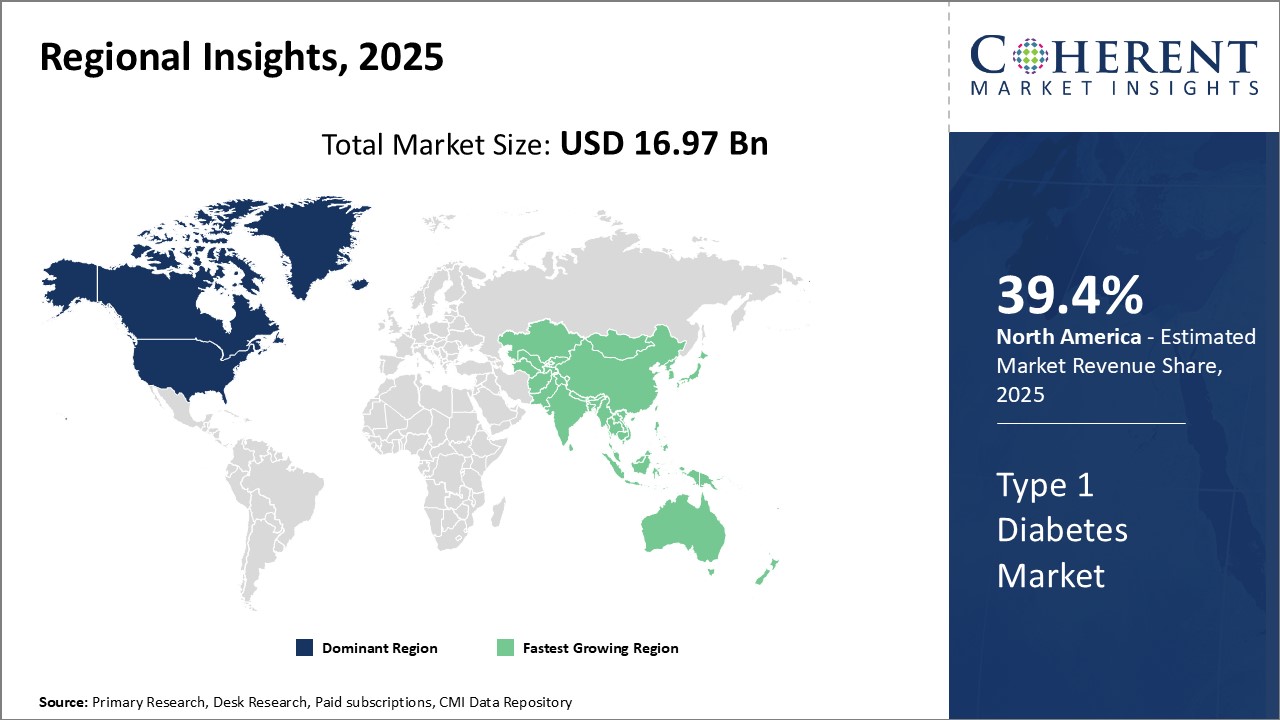
Need a Different Region or Segment? Download Free Sample
North America has established itself as the dominant player in the global type 1 diabetes market and is projected to hold 39.4% of the market share in 2025. The region accounts for a significant share of the worldwide market due to the presence of leading life sciences companies and advancements in research and development. The U.S. holds the bulk of the market in North America owing to factors such as rising healthcare expenditure, high awareness levels about diabetes management, and favorable reimbursement policies for novel therapeutics.
The Asia Pacific region has emerged as the fastest growing market for type 1 diabetes treatment and management. Nations like China, Japan, and India are witnessing rapid economic advancement alongside significant improvements in their healthcare systems. This progress is drawing the attention of multinational pharmaceutical companies to invest in these regions. With a substantial diabetic patient population, these countries present lucrative prospects for pharmaceutical manufacturers. Diabetes associations and support groups in Asia Pacific are also actively creating awareness and education programs to diagnose and manage type 1 diabetes at an early stage.
Market Report Scope
Type 1 Diabetes Market Report Coverage
| Report Coverage | Details | ||
|---|---|---|---|
| Base Year: | 2024 | Market Size in 2025: | USD 16.97 Bn |
| Historical Data for: | 2020 To 2024 | Forecast Period: | 2025 To 2032 |
| Forecast Period 2025 to 2032 CAGR: | 6.4% | 2032 Value Projection: | USD 26.22 Bn |
| Geographies covered: |
|
||
| Segments covered: |
|
||
| Companies covered: |
Biocon Ltd., Novo Nordisk, Gan & Lee Pharmaceuticals, Zealand Pharma, AstraZeneca, Eli Lilly and Company, Sanofi, Wockhardt Ltd., Ypsomed AG, Novartis, Panbela Therapeutics, Diamyd Medical, Adocia, Anelixis Therapeutics, Oramed Pharmaceuticals Inc. |
||
| Growth Drivers: |
|
||
| Restraints & Challenges: |
|
||
Uncover macros and micros vetted on 75+ parameters: Get instant access to report
Type 1 Diabetes Industry News
- On March 14, 2023, Lexicon Pharmaceuticals, a biopharmaceutical company, announced that it will resubmit a New Drug Application (NDA) to the U.S. FDA for approval of sotagliflozin to enhance glycemic control in type 1 diabetes patients with chronic kidney disease. According to the company, the NDA resubmission is set for mid-2024, with regulatory approval expected within six months.
- In November 2023, Sanofi launched "The 1 Pledge" movement, a nationwide education campaign. The "The 1 Pledge" project will be led by well-known celebrities, including artist and philanthropist Usher Raymond IV, whose child was diagnosed with type 1 diabetes at age.
- In April 2023, Sanofi, a multinational pharmaceutical and healthcare corporation, announced the completion of its acquisition of ProventionBio, Inc., a biopharmaceutical firm. The acquisition adds TZIELD (teplizumab-mzwv), a novel, fully owned, first-in-class medication for type 1 diabetes, to Sanofi's core asset portfolio in General Medicines, accelerating the company's strategy transition toward differentiated medicines.
- In August 2020, Mylan N.V. (acquired by Viatris, a global pharmaceutical and healthcare corporation), and Biocon Biologics India Ltd., a subsidiary of Biocon , a biopharmaceutical company, announced the U.S. launch of Semglee (insulin glargine injection) in vial and pre-filled pen formats. Semglee is approved to help control high blood sugar in adult and pediatric patients with type 1 diabetes, as well as adults with type 2 diabetes.
*Definition: Type 1 diabetes is a chronic autoimmune condition in which the body's immune system mistakenly attacks and destroys the insulin-producing beta cells in the pancreas. Insulin is a hormone that regulates blood sugar (glucose) levels in the body by facilitating the absorption of glucose into cells for energy. Type 1 diabetes usually develops during childhood or adolescence, but it can also occur in adults. Unlike type 2 diabetes, which is often linked to lifestyle factors such as obesity and physical inactivity, type 1 diabetes is not preventable and is not caused by lifestyle choices.
Market Segmentation
- Device Type Insights (Revenue, USD BN, 2020 - 2032)
- Insulin Pen
- Insulin Syringe
- Insulin Pump
- Insulin Jet Injectors
- Insulin Type Insights (Revenue, USD BN, 2020 - 2032)
- Long-Acting Insulin
- Rapid-Acting Insulin
- End User Insights (Revenue, USD BN, 2020 - 2032)
- Homecare Settings
- Hospitals & Clinics
- Academic & Research Institutes
- Others
- Distribution Channel Insights (Revenue, USD BN, 2020 - 2032)
- Hospital Pharmacies
- Retail Pharmacies
- Online Pharmacies
- Regional Insights (Revenue, USD BN, 2020 - 2032)
- North America
- U.S.
- Canada
- Latin America
- Brazil
- Argentina
- Mexico
- Rest of Latin America
- Europe
- Germany
- U.K.
- Spain
- France
- Italy
- Russia
- Rest of Europe
- Asia Pacific
- China
- India
- Japan
- Australia
- South Korea
- ASEAN
- Rest of Asia Pacific
- Middle East
- GCC Countries
- Israel
- Rest of Middle East
- Africa
- South Africa
- North Africa
- Central Africa
- North America
- Key Players Insights
- Biocon Ltd.
- Novo Nordisk
- Gan & Lee Pharmaceuticals
- Zealand Pharma
- AstraZeneca
- Eli Lilly and Company
- Sanofi
- Wockhardt Ltd.
- Ypsomed AG
- Novartis
- Panbela Therapeutics
- Diamyd Medical
- Adocia
- Anelixis Therapeutics
- Oramed Pharmaceuticals Inc.
Share
Share
About Author
Ghanshyam Shrivastava - With over 20 years of experience in the management consulting and research, Ghanshyam Shrivastava serves as a Principal Consultant, bringing extensive expertise in biologics and biosimilars. His primary expertise lies in areas such as market entry and expansion strategy, competitive intelligence, and strategic transformation across diversified portfolio of various drugs used for different therapeutic category and APIs. He excels at identifying key challenges faced by clients and providing robust solutions to enhance their strategic decision-making capabilities. His comprehensive understanding of the market ensures valuable contributions to research reports and business decisions.
Ghanshyam is a sought-after speaker at industry conferences and contributes to various publications on pharma industry.
Missing comfort of reading report in your local language? Find your preferred language :
Transform your Strategy with Exclusive Trending Reports :
Frequently Asked Questions
EXISTING CLIENTELE
Joining thousands of companies around the world committed to making the Excellent Business Solutions.
View All Our Clients
